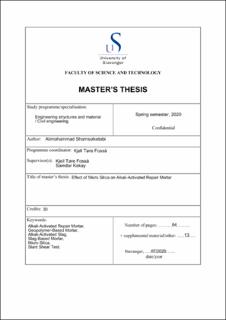Effect of Micro Silica on Alkali Activated Repair Mortar
Master thesis
Permanent lenke
https://hdl.handle.net/11250/2679700Utgivelsesdato
2020-07-14Metadata
Vis full innførselSamlinger
Sammendrag
In this era, concrete acts as a primary role in construction technology. Therefore, it is essential to pay widespread attention to the side effects of concrete products for the environment. On the other hand, the vulnerability of concrete against invasive environmental factors such as acids, sulfates, seawater, and freeze/thaw cycle can affect the concrete lifetime. Hence, it is smart to make significant investments to represent innovative methods to repair and extend the existing concrete structures against destructive factors mentioned above and utilize new material instead of cement to cover the weak points. Alkali activated material could be considered as a brilliant alternative to avoid the use of ordinary types of cement. This material can also be utilized in the shape of mortar to repair and improve the functionality of existing concrete structures. This thesis focused on using a wastage of metal production process as the base material to provide a binder with widespread potentials for using in repair mortars. Alkali-activated slag is going to substitute the ordinary portland cement to produce alkali-activated repair mortar. It is also tried to optimize the physical properties as well as compression and bond strength of this mortar for using in practice by finding the optimum percentage of micro silica powder. For this purpose, we do the vicat and mini-slump tests immediately after casting the mortar to measure the setting time and workability. Moreover, The slant shear test is done as well as the cubic compression test for different percentages of micro silica from 0 to 20. The slant shear test helps us to compare the bond strength of mortar in the desired bond interface. Besides, all experiments above will be compared with a reference mix design with ordinary Portland cement to make a better comparison with alkali-activated binders. As a result, 15% of micro silica shows an acceptable compressive and bond strength with allowable workability. Moreover, slag-based mortar shows a significantly shorter setting time compared to OPC mortar, which makes the alkali-activated mortar a considerable substitution for OPC mortars in repairing structures.
Beskrivelse
Master's thesis in Structural Engineering
